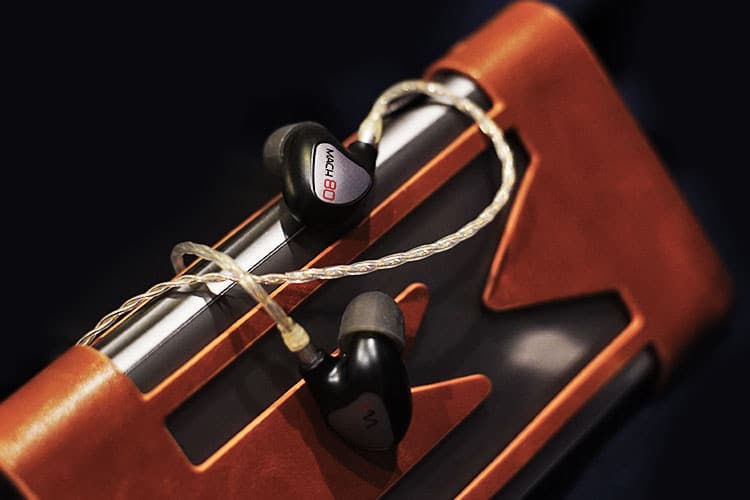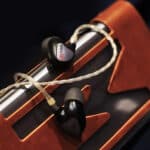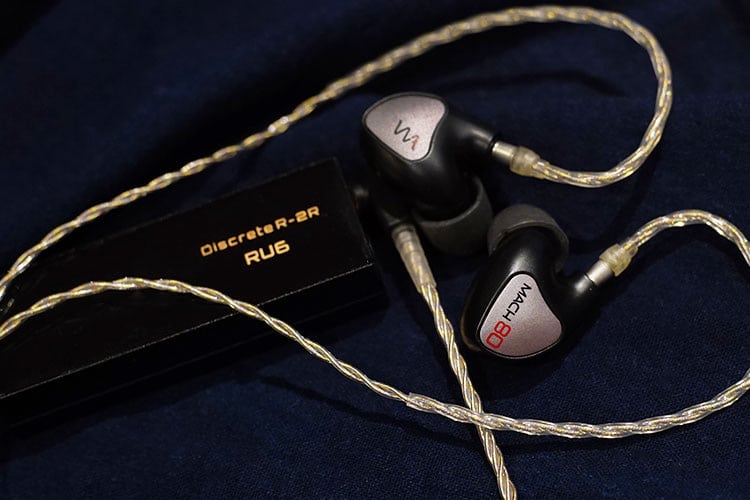In this review we listen, test, and compare the new Westone MACH 80 which is the company’s latest flagship 8 BA driver in-ear monitor. It is priced at £1,599.00.
Disclaimer: This is a sample that was sent in exchange for our honest opinion. Headfonics is an independent website that does not have any affiliate links or status. We thank Westone Audio and HiFi Headphones UK for this opportunity.
To learn more about previous Westone Audio products featured on Headfonics you can click here.
Note, that this article follows our latest scoring guidelines which you can read up on here.
Things have been changing in the last few years with Westone Audio acquired by the professional hearing aid company Lucid Audio, and we can see a big step forward in the new lineup’s ID design.
With all that happening it’s hard to believe it has been about 6 years since the launch of the previous flagship universal IEM from Westone called the W80.
However, we have fresh new shiny things with the new March series of universal monitors. The Mach 80 is their flagship model in the range and, on paper, there are some similar themes carried over from the old W range including driver counts, and lightweight design elements, but the sound? Yup, this is no W80 MK2.
Tech Highlights
The MACH 80 features a proprietary system with 8 balanced armatures including dual low, dual mids, and quad highs, under a 3-way passive crossover.
The configuration hints that the bass will not be over-emphasized and the treble should be highly controlled and intensive having four tweeters down the hood.
In fact, Westone Audio is one of the pioneers in making multi-BA IEMs with no less than 3 generations of the W8 as well as their professional series such as the ES80. Clearly, they are taking the chance to blend the merits of the different models into one.
Westone Audio does not reveal much information regarding the specifications of the MACH 80, but from what is disclosed, the frequency response on the MACH 80 is incredibly wide covering from 5Hz to 22kHz. Its impedance rating suggests that it could take on powerful swings from higher-end DAPs and amplifiers for higher performance.
Instead of using the conventional MMCX terminations, the MACH series has moved on to the T2 connector system, which promotes high durability and is IP-67 Proof. We are fans of the T2 system, they are generally quite robust for heavy-duty usage and prolonged product life.
Design
The MACH 80, or the full MACH series that shares the same design, looks more stylish while feeling way more reliable than the previous W series. The housing combines a metallic covering on a lightweight but rigid polycarbonate housing with a satin finish and is topped with a new logo design.
Flipping to the other side we have a thin nozzle that I could easily associate with more controlled bass and a cleaner tuning. The molding is flawless and the whole earpiece feels very sturdy.
Beyond the sleek design and new curves, the layered colors boost the experience nicely as well. To be frank, I find the design and material on the previous W series not as premium compared to what the competition offers. The MACH series does a much better job with the color palettes.
While the industrial design approach on the MACH series is substantially more appealing, at the same time the cable extrusion angle is tilted more friendly, allowing the cable to naturally go around the back of the ears and the design to look sportier.
In short, the material design on the MACH 80 is well executed, while being very lightweight it does not compromise the looks and durability.
Together with their True-fit foams and the Estron cable that has a light profile as well, this is one of the very few flagships tier items that you may forget its existence in the ears, which is perfect on or off stage.
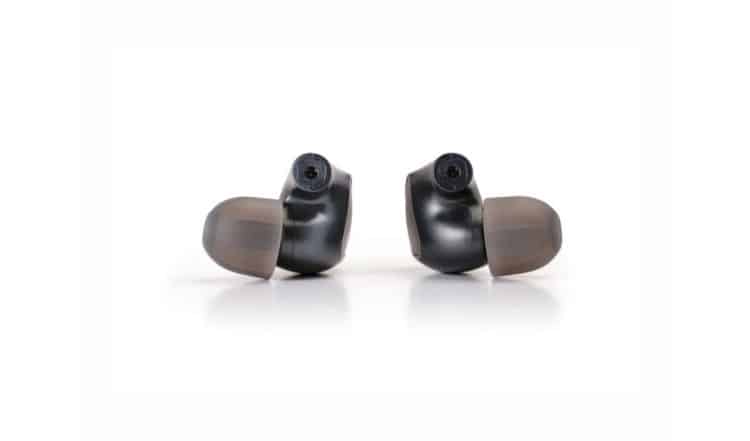
Comfort & Isolation
The Westone MACH 80’s enclosure is very compact and extremely light despite having 8 drivers inside. Needless to say, the comfort is awesome which has been the case for their previous iterations also.
Isolation is excellent with a slightly deeper fit than average IEMs, using Westone’s True-fit foams and high-quality flanges the seal and noise blockage are excellent.
The fitting is top notch and I am quite sure it could fit any ears comfortably, there is no stress caused by the cables. It can almost deceive my brain to feel like I am not wearing an IEM.
The MACH 80 sits cozily on the cavum and hangs almost weightlessly on the ears, and it is free from microphonics when tightening with the cable chin lock at the back of my neck.
Tips
Within the package, you will get 5 pairs of flanges and 5 pairs of foams including Westone Audio’s high-density True-fit foams. Different sizes are supplied for users to find their best fit and foams are of high density that could easily seal off ambient noises.
I am using the supplied foams for more elaborated bass and swapping to the flanges gives a more balanced output and enhanced control, especially in the low end.
Despite having a small nozzle diameter the bass on the MACH 80 goes deep and expansive, when using foams that have excellent sealing power, the bass impact is well delivered and sounds fuller.
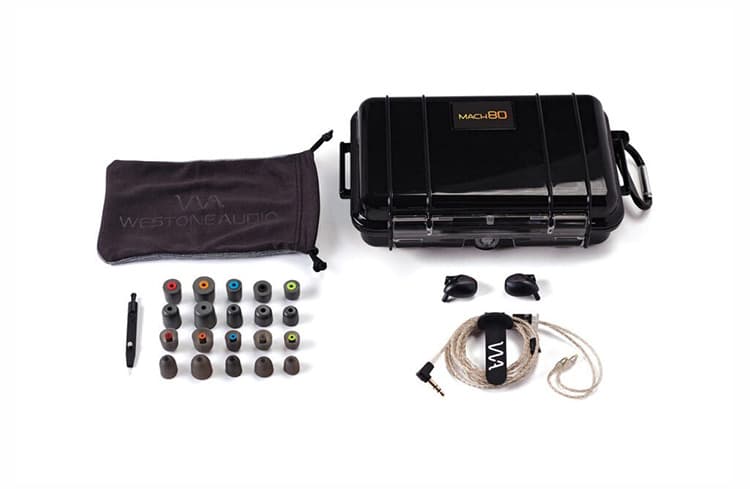
Stock Cable
The inclusion of the Linum Estron UltraBaX cable designed by the Denmark company Estron a/s completes the package, not just by how it looks but by how it matches the tuning of the MACH 80 while not adding up the impedance and colorings.
The UltraBaX quad-twisted design with 224 cores measures only 0.6Ω in impedance, despite the fact that it doesn’t have a large gauge.
The UltraBaX looks premium and not very thin; some of the T2 terminated cables are almost weightless and too thin, but in other words, these are perfect for stage use or for those who like to put the cables at the back of the neck.
The slider is worth some compliments as well. It slides very smoothly and has a locking mechanism that is perfect if you don’t want microphonics when working out with the earphones.
Packaging & Accessories
Packaging with the MACH 80 is more graphical than what we have seen on the W80 which has an artistic design. It is an effective display with excellent printing quality and all the product detail on the back of the box.
Digging inside, you would find a big pack of foam tips and silicone flanges, a huge Pelican case loved by professionals. Aside from that, Westone Audio also supplies a cloth bag and cleaning tools which could be very useful for cleaning the nozzle out.
Sound Impressions
Summary
While there is still a good hint of the so-called Westone Audio’s house sound, the coloration in the midrange is less than on the W80 and it sounds overall more balanced. The MACH 80 is exceptionally smooth, punchy, and well-articulated. It is also able to capture the rumble down at the very low end.
You could hear every element clearly all across the spectrum. The edges of the image of every instrument are clearly defined while being naturally separated in the headroom rendered without overly stressing transients or certain frequencies. Overall, a nicely balanced and subtly lush sound with a gentle lift in the lower mid-range.
Some may find the tuning slightly laid back or a tad bit dark in the first few minutes of listening, but from a few songs onwards the depth and spacious headroom rendered will definitely grow on you.
When paired with powerful gears and mixing interfaces the MACH 80 also yields high transparency and an uncolored tone. Aside from that, the MACH 80 is distortion-free and strong in definition even at very high volume, also consistent in tone pairing with different gears.
Bass
There are two balanced armatures dedicated to bass reproduction and that doesn’t mean that the bass on MACH 80 is short of power compared to the 4 tweeters that handle the treble.
Instead, the bass extends very deeply sounding punchy with good energy in the very low end. The smooth mid-bass proposition allows the lower register to be clearly heard, including the fast attacks and expressive decay that follows.
Testing with frequency sweep test tracks I can hear the bass going really deep down and firm, decaying into the rendered space with excellent definition.
I don’t have bat ears to hear it goes as low as 5Hz but it certainly can bring out a very faint rumble in the mix sounding nicely layered when testing with synths. The image for bass instruments is dense and tight, capturing energy bursts and bass transients effortlessly and favors electronic music as well as fast percussions.
The mid-bass isn’t emphasized, but I won’t call it very conservative either, it is just the right amount with sufficient speed and fullness to define very fast pickings and drum attacks distinctly. There is sufficient energy and presence to fill up the space rendered while keeping all instruments steadily in place in a very controlled manner.
The rather neutral tuning captures the ambiance and room acoustics dutifully to sound very live-like and realistically airy, without dampening the brilliance and details of the higher frequencies. There is some excellent texture and dynamics that help to inject good musicality, air, and energy to the low end.
Mids
The mid-range is smoothly articulated from the upper bass, from which you could hear a gentle push for lushness in the very lower mids. This is then followed by a gentle dip for more openness and clarity, coloring the midrange clean.
With good roundness and energy from the lower end, the vocal does not sound thin and is well outlined. The upper midrange frequencies are slightly forwarded to strengthen the image and presence of vocalists.
The mids are also highly responsive, with decent authenticity and enhanced transient response. The smoothly rendered midrange preserves plenty of air, spaciously separating each instrument and reproducing them with an even spread of energy across the frequency spectrum.
This allows details in different frequencies to be heard clearly and the effects when applying equalizers and plugins are easily detectable.
With some very clean tracks, the monitoring-styled tuning from the MACH 80 may feel a bit dry. However, streaming content that need the dynamics, or old pops from the 70s and 80s that have stronger midrange coloration and effects applied, sounds fantastically smooth.
The MACH 80 can very well capture the electronic vibes and qualities in the mixes and allows the listener to clearly pick out the subtle changes in vocal power.
Testing with acoustic tracks and Jazz on the Shanling M9, the vocal and the ambiance is rendered lively and cohesively. Double-tracking vocal mixes, for example, tracks from ABBA and Bee Gees that stack their vocal line up, sound sweet and buttery smooth, well positioned up front, sounding well controlled.
Treble
The higher register on the MACH 80 is beautifully rendered with strong tolerance to sudden swings, also able to handle small nuances in a big ensemble.
The treble has a great sense of coherence and control, instruments across the upper midrange to the treble zone sound tight even at very high sound intensity, probably as a result of the quadruple balanced armatures implemented.
The MACH 80 is capable of handling intensively attacking treble, such as smashing gongs and hard-hitting cymbals, which are livelily captured without distorting and bleeding over the edges.
Dynamics are also well preserved with the MACH 80 maintaining a steady, resolving, and slightly laid-back presentation that is able to take on a large number of instruments stacking over each other but without getting messy at all.
The smooth presentation is very friendly to EDMs, synth instruments, ringing tones, vibrating notes on saxophones, and sustaining guitar harmonics with its highly resolving and incredibly airy treble.
In many IEMs the treble is rolled off earlier and even though that may sound sweet, the headroom created would be less realistic and bound to be less expansive. The MACH 80 sounds just right without being overly exciting or killing the air. Even when the passive isolation is awesome once the songs are playing it doesn’t sound contained or dampened.
Further stress testing it with distorting guitars and loud voices, I can confirm the MACH 80 is very capable of handling intensive trebles while capturing a lot of details. It almost gets over the edge but is carefully rounded off before it reaches the threshold, preserving the energy nicely and keeping the output dynamic and enjoyable.
Staging
The headroom rendered on the MACH 80 is very spacious because of the smooth mids and excellent extension on both ends. The stage rendered is also incredibly layered such that you can detect nuances in vibratos or pick out the point where the instrument is radiated from.
Instruments are spaciously separated on both the x and y axis, so the vocal is positioned not very intimately, though you won’t feel the distance being too far nor are the midrange instruments and vocal sounding hollowed out.
With an even energy spread the headroom on the MACH 80 sounds holographic and realistically rendered, expansive yet highly defined as if you are listening in an acoustically treated room that could accommodate powerful bass.




